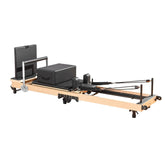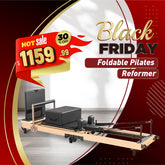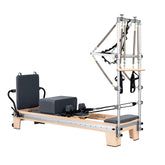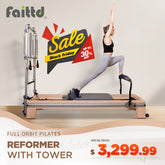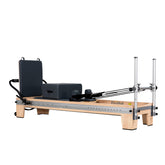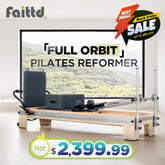How to Use Pilates Reformer for Injury Prevention & Rehabilitation?
The Pilates Reformer is a game-changer for improving your physical health. Its low-impact design makes it perfect for building strength, flexibility, and balance without straining your body. Whether you're recovering from an injury or managing chronic pain, this tool can help. Many people, including therapists, have seen how Pilates supports rehabilitation and prevents future injuries. With proper guidance, you can tailor the Reformer to meet your unique needs and goals.
Key Takeaways
- Pilates Reformer is soft and helps you get stronger, more flexible, and more balanced. It helps keep you from getting hurt and speeds up your healing.
- Core workouts like the Reformer Plank can help fix your posture and lower your risk of getting hurt.
- Leg circles and bridges are two exercises that help keep muscles balanced and prevent injuries from overuse.
- Stretches like the Mermaid Stretch make you more flexible and help your joints move better, which keeps you from getting hurt.
- If you learn from trained teachers, you'll stay safe and get exercises that will help you recover.
Benefits of Pilates Reformer for Injury Prevention & Rehabilitation
1. Core Stability and Postural Alignment
Think of your core as your body's natural support system. When strong, it protects your spine, improves posture, and helps prevent injuries throughout your body. Other parts of your body won't have to work as hard if your core is stable. This lowers the risk of strain and damage. Important exercises:
- Reformer Plank: Engages your deep core muscles while the moving train naturally tests your balance
- Footwork Series: Strengthens the core and aligns the legs, laying the groundwork for stable action
2. Balanced Muscle Development
All of our muscles should work together for the body to be at its best. The Pilates Reformer can help you find and fix muscle weaknesses that could hurt you. You can move more quickly and safely if you improve weak spots and stretch tight spots. Key exercises:
- Leg Circles: Smooth moves that make the hips more flexible and show and fix any differences between the left and right sides
- Bridging: Strengthen your back and loosen up your hip flexors at the same time
3. Flexibility and Joint Mobility
You don't have to be able to touch your toes to be flexible. Being flexible means being able to move around easily and comfortably in everyday life. The Reformer's controlled, smooth moves help you improve flexibility without overstraining. Key exercises:
- The mermaid stretch makes your spine more flexible and opens up your whole side body
- Tendon stretch loosens up tight leg muscles and helps the spine move better
4. Proprioception and Coordination
Better body awareness means better movement control and fewer injuries. Pilates reformers provides a safe space to challenge your balance and coordination, helping your body learn where it is in space and how to move more confidently. Key techniques:
- Practice standing exercises on the moving carriage to improve balance
- Use foam pads or stability discs to enhance body awareness
- Focus on smooth, controlled movements rather than speed
- Start gently and build gradually—good form creates better results than rushing through exercises

Key Pilates Reformer Exercises for Strength, Flexibility, and Balance
1. Strengthening Exercises
Teaser on Reformer for core endurance
The Teaser on the Pilates Reformer is a powerhouse move for building core endurance. You start by lying on the carriage with your feet in the straps. As you lift your upper body and legs into a V-shape, your core muscles engage deeply to stabilize you. This exercise strengthens your abdominals and improves spinal control. It’s challenging but incredibly rewarding. If you’re new to this, begin with a modified version by keeping your knees bent.
Single-Leg Stretch for hip flexor strength
The Single-Leg Stretch is another fantastic exercise for strengthening your hip flexors and improving core stability. While lying on a full-orbit Pilates reformer with tower, you extend one leg out while pulling the other knee toward your chest. The straps provide resistance, making your muscles work harder. This move not only targets your hip flexors but also engages your lower abdominals. It’s a great way to build strength and improve coordination.
2. Flexibility Exercises
Pelvic Curl for lumbar mobility
The Pelvic Curl is a great way to make your lower back more flexible. Sitting on the Reformer with your feet on the foot bar, you slowly raise your hips into a bridge shape. This move makes your hips stronger and stretches your lower back. It helps keep your lower back from getting stiff, which is especially helpful if you spend a lot of time sitting.
Open up your hips and shoulders with the mermaid stretch
The Mermaid Stretch is a great way to make your hips, shoulders, and upper spine more flexible. It also stretches your inner legs and obliques, getting your body ready for more difficult moves. Here is a quick list of its advantages:
| Benefit | Description |
| Increases hip mobility | Enhances the range of motion in the hip joint. |
| Increases shoulder mobility | Improves flexibility in the shoulder area. |
| Improves thoracic spine mobility | Aids in better movement and flexibility of the spine. |
| Stretches side body muscles | Targets obliques and inner thighs for flexibility. |
This stretch leaves you feeling open and aligned, making it a favorite for many Pilates practitioners.
3. Balance Exercises
For back support, swimming on a Reformer machine
Swimming on the Reformer is a fun and effective way to make your back stronger and your balance better all around. You lie on the train with your face down and lift each arm and leg in turn. This practice makes your back muscles stronger and your coordination better. It helps you become more stable while keeping your moves smooth and under control.
Standing balance exercises on the carriage
It might sound scary to stand on the moving train, but it's a great way to test your balance. Holding on to the foot bar for support, you can start with easy moves like squats or lunges. You'll find that your ankles, knees, and hips are more stable over time. These routines not only help you keep your balance, but they also make you feel better about how you move in everyday life.
Tip: Always focus on control and alignment during balance exercises. Start with light resistance and progress gradually.

Customizing Pilates for Rehabilitation and Specific Conditions
1. Low-Impact Recovery
Footwork with light springs for knee healing
When you're healing from knee pain, Pilates reformers can save your life. Footwork with small springs is a gentle way to get your knees stronger and more mobile again. You can work on controlled leg movements without putting too much stress on your joints by lying on the carriage and pressing against the foot bar. Your quadriceps, hamstrings, and legs will get stronger and your knee alignment will get better with this low-impact exercise. To keep from getting too tired, start with less force and focus on moving in a smooth, controlled way.
Shoulder recovery: Arm circles with straps
Shoulder pain can make it hard to move your shoulders, but arm rounds on the Reformer with straps can help. You can stretch and strengthen your shoulder muscles with this practice. Hold the straps and move your arms slowly in a circle while lying on the cart. You can work out your muscles without overworking them because the straps' pressure is just right. This method of rehabilitative exercises is great for making the shoulder more stable and mobile while you're healing.
2. Targeted Muscle Activation
Single-leg presses for ACL repair
Still healing from an ACL injury? On the Reformer, single-leg pushes are a great way to get your knees stronger and more stable. You can work on the muscles around your knee joint by focusing on one leg at a time. Keep your moves under control as you put one foot on the foot bar and push the carriage away. This exercise not only makes your quads and hamstrings stronger, but it also makes your balance and coordination better, which are very important for staying healthy and recovering from injuries.
Hip labral tear: Side-lying leg lifts
Side-lying leg lifts on the Reformer can help with a hip labral tear because they work the smaller muscles that keep your hips stable. Help yourself by lying on your side with your top leg straight and your bottom leg bent. Move your top leg up and down with the strap to add pressure. This exercise makes your hips more stable and strengthens your gluteus medius, both of which are important for easing pain and speeding up your healing.
3. Progress Over Time
Approach in stages: acute, subacute, and functioning stages
It takes time to get better, but Pilates can help you through each step. To ease pain and swelling during the acute phase, do light, low-impact movements like passive stretching. As you move into the subacute phase, do more active things to build your strength, like light resistance workouts. Lastly, move on to useful movements that are dynamic and look like things you do every day. This step-by-step process makes sure that your body heals properly and safely.
4. Pain Management
Having to deal with constant pain can be hard, but Pilates is a gentle and effective way to feel better. You can use the Pilates Reformer to do exercises that can help ease pain and improve your range of motion whether you have osteoarthritis or sciatica.
Chronic conditions: Exercises for osteoarthritis and sciatic pain
You know how important it is to take care of your joints while being busy if you have osteoarthritis. Pilates is a great way to get stronger without putting too much stress on your joints. It also makes you more flexible and increases your range of motion, which can make it easier to do everyday things. Studies have shown that Pilates can help people with long-term conditions like gout feel a lot less pain. You can do great exercises like the Footwork Series or Bridging. They keep your joints supported and straight while making your muscles stronger.
If you have sciatica pain, the Reformer can help take pressure off your hips and lower back. The Pelvic Curl and other moves that slowly stretch and work your core can help relieve tension around the sciatic nerve. The Mermaid Stretch is another great choice. It opens up your hips and makes your spine more flexible.
Techniques: Spinal decompression and gentle mobility work
If you have sciatica pain, spinal release exercises on the Reformer can help a lot. These exercises help herniated discs and the sciatic nerve feel less pressure by slowly stretching your spine. This helps the wounds heal, lowers swelling, and increases blood flow to them. Feel free to try the Short Spine Massage. Stretching your back and letting go of stress is easy and effective.
Another important way to deal with chronic pain is to do gentle movement work. On the Reformer, moves like "Cat-Cow" make your back more flexible and let you move around more easily. These routines are great for rehabilitation because they don't hurt you and are easy to change to fit your needs. You'll feel less stiff and more confident in your moves over time.
Tip: Always listen to your body. Start with light resistance and focus on slow, controlled movements. If something feels uncomfortable, stop and adjust.

Safety Tips for Using the Pilates Reformer
Consulting Experts
Working with certified instructors or physiotherapists
When it comes to injury prevention and rehabilitation, working with a certified instructor or physiotherapist is essential. These experts know how to safely lead you through Pilates movements, making sure you use the right form and are in the right place. They can also change the way you move to fit your needs, whether you're trying to avoid getting hurt or are healing from one.
To learn how to use the Pilates Reformer, certified teachers have to go through a lot of training. The standards they usually meet are broken down below:
| Requirement | Hours |
| Movement Principles | 16 |
| Balanced Body Reformer 1 | 16 |
| Balanced Body Reformer 2 | 16 |
| Balanced Body Reformer 3 | 16 |
| Reformer Personal Sessions | 30 |
| Observation Hours | 30 |
| Student Teaching Hours | 90 |
| Total Hours | 214 (not including anatomy) |
This extensive training ensures they can tailor programs to your unique goals and physical condition.
Tailoring programs to individual needs
The way you do Pilates should be tailored to your body type. A certified teacher can look at your weaknesses, talents, and any injuries you may already have. They will make a plan just for you that is based on your goals, like getting stronger, more flexible, or less in pain.
Avoiding Common Mistakes
If you want to use the Pilates Reformer safely and effectively, don't make these common mistakes: skip the warm-up, increase the resistance too quickly before learning the right way to do it, keep bad posture during exercises, overuse your shoulders instead of engaging your core, hold your breath during movements, rush through exercises instead of staying in control, and put your feet on the footbar in the wrong place. If you have a good teacher, it's easy to avoid all of these mistakes.
Contraindications
Avoiding moves with a lot of force for new injuries
If you have a recent injury, don't do any intermediate or high-impact moves on the Reformer. These things can make your situation worse and make it take longer to get better. Don't do anything too hard, like Footwork with light springs or easy stretches. Talk to your instructor before starting a new exercise to make sure it is safe for you.
Extra care for people with osteoporosis and other illnesses
Some health problems, like osteoporosis, need extra attention. Fractures are more likely to happen when you do sports or moves that put a lot of stress on your body. Instead, do weight-bearing workouts with low impact that will make your bones stronger and help you keep your balance. One great idea is to do standing balance training on a carriage. Always let your teacher know about any health problems you have so they can make changes to your program.
Tip: Safety comes first. Listen to your body and communicate openly with your instructor to avoid unnecessary risks.

Build Strength Safely: Try Pilates Reformer Rehabilitation
The Pilates Reformer makes injury prevention and rehabilitation simple and effective. Each session brings you closer to your goals, whether you're just beginning or looking to level up your practice.
Here's what you'll gain from regular practice:
- Stronger muscles without strain
- Better flexibility
- Improved balance
- Better posture
- Stable core strength
Starting is easy. A qualified instructor will guide you through exercises that match your needs and abilities. Whether you're recovering from an injury or working to prevent one, each session brings clear progress.
Why wait? Take that first step toward better movement and lasting wellness with Pilates Reformer training today.
FAQ
Q1: Is the Pilates Reformer suitable for chronic pain management?
Yes, it's great for dealing with long-term pain. Low-impact workouts on the Reformer make muscles stronger and joints more mobile without putting stress on the body. Some exercises, like the Pelvic Curl or the Mermaid Stretch, can help people with osteoarthritis or sciatica feel better and move around more easily.
Q2: Do I need special clothing for Pilates Reformer sessions?
Wear comfortable, form-fitting clothes that allow you to move freely. Avoid loose garments that could get caught in the Reformer’s moving parts. Grip socks are also recommended for better traction and safety during your workout.
